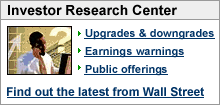|
End to rate hikes could end rally
The end of the Fed's interest rate-hiking campaign may not be so good for stocks, despite investors' bets.
NEW YORK (CNNMoney.com) - An end to rate hikes is near...and that could be a bad thing for bulls. Bets that the Federal Reserve's 22-month rate-hiking campaign is nearing an end has helped support market sentiment and lift stocks this year. It's been a catalyst even as the bull market deals with a string of negatives: old age, slowing earnings growth, oil and gold prices near record highs, and the threat of a slowing housing market.
"The market is really looking forward to rate hikes being done," said Jeff Kleintop, chief investment strategist at PNC Advisors. "We typically get a 3 percent bounce in the six weeks ahead of the last hike." But the stock market often gets little benefit six or 12 months down the line, according to recent studies from research firms, including Ned Davis Research (see chart for details). Stocks got a nice bump up Thursday after comments from Fed chief Ben Bernanke suggested that the central bank could be set to take a pause, perhaps as soon as the June meeting. Bernanke's comments and the bets of traders on the Chicago Board of Trade suggest that another rate hike is assured at the May 10 meeting. Bernanke noted that the economy has bounced back strongly in the first quarter of 2006, but that growth would likely slow a bit in the second quarter. At the same time, inflationary pressures remain contained, even amid the run up in commodity prices. After 15 quarter-percentage point rate hikes in a row, the central bank's target for its fed funds rate, a key overnight bank lending rate, stands at 4.75 percent. The Fed has been slowly removing liquidity from the economy after having cut rates substantially in the aftermath of the events of September 11 and the fallout from the bursting of the tech bubble in early 2000. Bernanke was basically laying out a roadmap for what the Fed might do in the coming months, said Michael Darda, chief economist at MKM Partners. "Essentially, he's saying that they may pause around 5 percent after the May meeting," Darda said, adding that he thinks the Fed may go to 5.25 percent before stopping. Stock investors want a pause
Stock investors don't like higher interest rates because they ultimately slow the flow of money through the economy and slow corporate profit growth, thus making stocks less appealing. So it's understandable why an end to rate hikes would seem like it would be supportive for stocks. But that's not necessarily the case. That's partly because it can take another 6 to 12 months for the effects of the last rate hikes to be felt. But it's also because sometimes in the past the Fed has stopped its campaign either too soon or too late, with negative consequences for the economy that in turn hurt stocks. Jane Caron, chief economic strategist at Dwight Asset Management, took a look at stock performance after the last three times the Fed ended tightening campaigns, in 1989, 1995 and 2000. How stocks behaved in the months after was dependent on the economic backdrop that accompanied the end of the tightening. "In 1989, inflation was on the upswing and continued to rise the following year, which did not work out favorably for the stock market," she said. "In 1995, inflation was tame and slowed the following year while GDP growth was reasonably healthy and strengthened and the stock market performed very well." Clearly, the response to the end of tightening in 2000 was not so good, with stocks heading into a three-year bear market. Will 2006 be different?
How 2006 shapes up for stocks will depend on how the economy performs in the next few quarters, specifically if it starts to slow, as Bernanke said Thursday. It also depends on whether the Fed is right to bet that the cooling of the housing market is a bigger threat to consumer spending than rising oil prices. That's something Bernanke hinted at Thursday and something MKM's Darda is not so sure about, noting that the impact of higher commodity prices can take months or even years to be fully felt. The risk is that if the economy turns out to be hotter than the Fed is thinking, it will have to resume raising rates in the fall, perhaps after pausing for a meeting or two, which would be negative for stocks, said Michael Sheldon, chief investment strategist at Spencer Clarke. On the other hand, if what the Fed has done so far is enough to create a non-inflationary environment with moderate economic growth, that would be a positive. Investors will need to watch the numbers closely to see which scenario is developing, Sheldon said. "If we see signs that the economy is in fact slowing, and inflation remains contained, then the pause is a positive for stocks," said Sheldon. "But if we see tightness in the labor market, pressure in commodity markets, that could suggest we will see further hikes." ------------------- Stocks: Playing the worst 6 months. Full story. A second-quarter road map. More here.
Too strong for its own good? Click here. |
|




